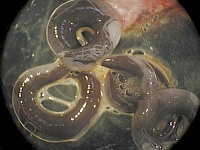Anguillicola crassus
Eel Swimbladder nematode
Synonym(s): Anguillicoloides crassus
Class: Secernetea
Order: Spirurida
Family: Anguillicolidae
Photographer: Bill Bessmer
Source: Wikimedia Commons
Description
The adult nematode Anguillicola crassus is covered by a soft wrinkled outer cuticle. Males measure 20-60 mm while females measure 47-71.5 mm. The mouth has a circular opening surrounded by 4 cephalic papillae and 2 lateral amphids. Males have 6 pairs of caudal papillae. Females posses a cone-shaped vuvla on the posterior end of the body and a white uterus which occupies most of the body housing copious amounts of eggs.
Symptoms: Infection from A. crassu can occur as early as the glass eel stage resulting in acute inflammatory reactions such as fibrosis and fibrotic conglomerates in the swimbladder. Scar tissue build up causes constriction of the intestine and can lead to rupture of the swimbladder. Emaciation from the swimbladder rupture can increase risk of bacterial infection resulting in increased mortality rate. Further vulnerability to secondary bacterial infection results from increased cortisol levels when infected with this nematode.
Host(s): European eel (Anguilla anguilla), American eel (Anguilla rostrata), and the Japanese eel (Anguilla japonica)
Ecological Threat: Anguillicola crassus is hearty and an aggressive colonizer, resulting from large egg production and low intermediate paratenic host specificity. Reports of infestation in 1989 increased from 10% to 50% within a one year time period. With the American eel population already declining, the introduction of this nematode may have a large negative impact on the survival of this species. This is a result of reduced swimming ability from infection rendering the eel vulnerable to predators such as the cormorant. Moralities have been reported in eel farms in addition to reduced growth rate, which has a large impact on economic output of the eel farm.
Biology: Eggs are hatched inside the female within the definitive host. The larvae emerge from the swim bladder of the eel and are released into the water from the host intestine. Larvae can survive for extended periods of time in the free living stage before ingestion by an intermediate or paratenic host or such as copapods or fish. Once the intermediate or paratenic hosts is consumed by the definitive host (eel) the larvae undergo two molts to develop into the adult stage within the swimbladder of the host. This life cycle is relatively short and can be completed within 2 months with cooperative host availability.
History: It is believed that A. crassus was transported to Europe from Taiwan in the 1980's within a shipment of eels. By the late 1990's this nematode was documented throughout Europe, and had become established in high prevalence in the European eel.
U.S. Habitat: Anguillicola crassus can remain viable in seawater at the adult and egg stage, but hatching is reduced from increased salinity. This nematode has the highest rate of survival in freshwater environments and higher temperatures. Studies have shown significant decline in growth rate of larvae and increase mortality of adult worms in colder water.
Distribution
Native Origin: Southeast Asia
U.S. Present: New York, Delaware, Maryland, North Carolina, South Carolina, and Florida.
Texas: Reported in south Texas aquaculture facilities, but not yet in wild American eel populations.
Management
The main vector of dispersal has been identified as humans. It is important to monitor and quarantine eel farms to prevent further spread of this nematode. Providing information and awareness is the only current method of management. If an infection is suspected it is important to notify local authorities and prevent uncontrolled migration when possible.
SEARCH Online
Google Search: Anguillicola crassus
Google Images: Anguillicola crassus
NatureServe Explorer: Anguillicola crassus
Bugwood Network Images: Anguillicola crassus
References
Ashworth, S. T., and Blanc, G., 1997. Anguillicola crassus, a recently introduced aggressive colonizer of European eel stocks. Bulletin Francais de la Peche et de la Pisciculture 344/345: 335-342.
Barse, Ann M., Scott A. McGuire, Melissa A Vinores, Laura E. Eierman, and Julie A. Weeder. 2001. The swimbladder nematode Anguillicola crassus in American Eels (Anguilla rostrata) from middle and upper regions on Chesapeake Bay. Journal of Parasitology 87(6): 1366-1370.
Belpaire, C., De Charleroy, D., Thomas, K., van Damme, P. and Ollevier, F. 1989. Effects of eel restocking on the distribution of the nematode Anguillicola crassus in Flanders, Belgium. Journal of Applied Ecolology 5: 151-153.
Evans, D. W., and M. A. Matthews. 1999. Anguillicola crassus (Nematoda, Dracunculoidea); first documented record of this swimbladder parasite of eels in Ireland. Journal of Fish Biology 55: 665-668.
Kennedy, C. R., and Fitch, D. J., 1990. Colonization, larval survival and epidemiology of the nematode Anguillicola crassus, parasitic in the eel, Anguilla anguilla, in Britain. Journal of Fish Biology 36: 117-131.
Koops, H., & Hartmann, F., 1989. Anguillicola infestations in Germany and in German eel imports. Journal of Applied Ichthyology 1: 41-45.
Internet Sources
http://www.nobanis.org/files/factsheets/Anguilicola_crassus.pdf
 Texas Invasive Species Institute
Texas Invasive Species Institute
